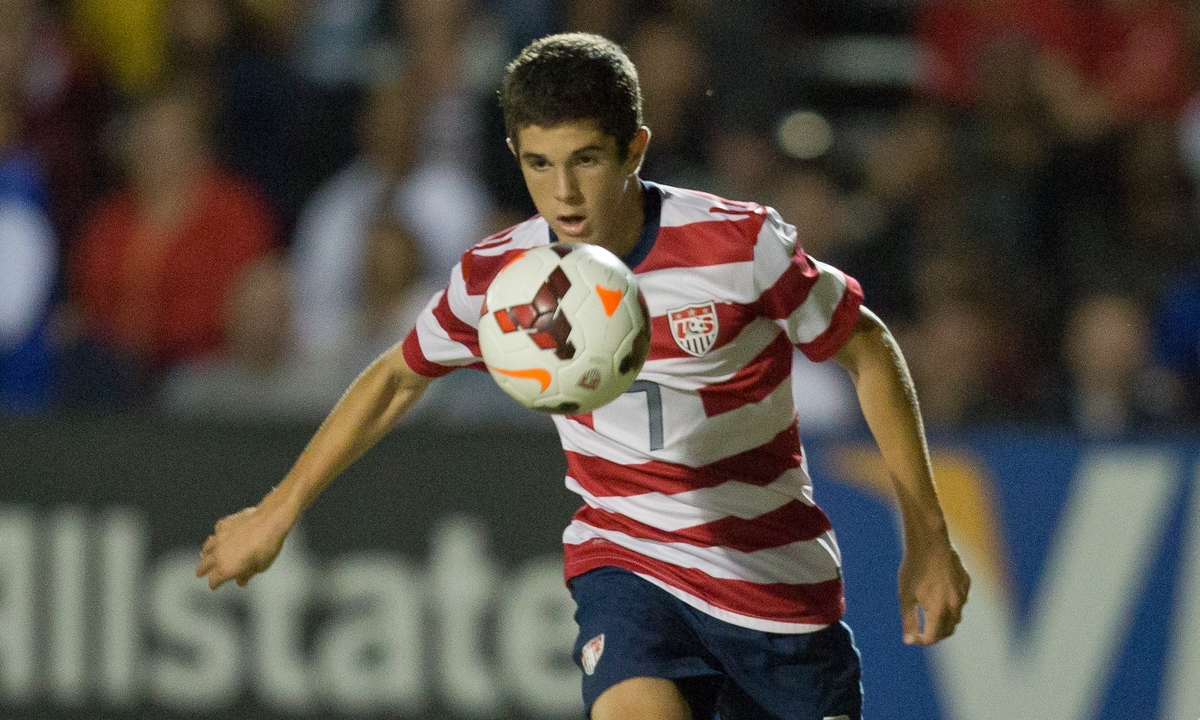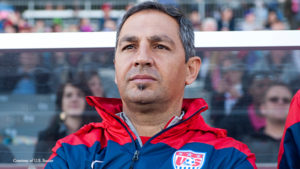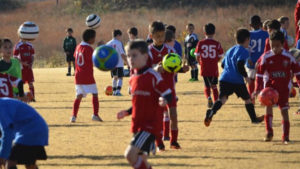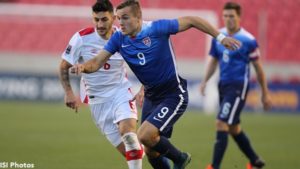SoccerWire Q&A: U-18 National Team coach Omid Namazi (2 of 2)

In part two of SoccerWire’s conversation with U-18 Men’s National Team head coach Omid Namazi (read part one here), Namazi discusses the youth national team’s performances in 2015, national playing style, the challenges facing would-be young professional players in the U.S. and the perspective that Namazi can bring to dual-national and immigrant players.
 SoccerWire.com: 2015 was an up and down year for U.S. Soccer. The U-20s did well. The U-17s – at least as viewed from the outside – did not. What’s the attitude been like inside the fed and what are they hoping to do differently going into future tournaments?
SoccerWire.com: 2015 was an up and down year for U.S. Soccer. The U-20s did well. The U-17s – at least as viewed from the outside – did not. What’s the attitude been like inside the fed and what are they hoping to do differently going into future tournaments?
Omid Namazi: Soccer is not a game where you can predict results. You can work hard and that’s the basis of what we do: we work as hard as we can and we hope that our work will bear fruit and give us the result we want [it] to. Sometimes it happens more consistently and sometimes, like recently, we’ve had some bad results.
But that doesn’t mean that the work ever stops. We continue to work and we hope that through developing more players and making this pool of players larger and larger, now we’re developing a lot more technical players. We’ve got to add the element that we used to have in the U.S. and that’s a never-die attitude, that toughness, that competitive edge. We need to bring that back a little bit and make sure that when we go into international competitions we’re competing and we’re getting the results we want to.
Again, the attitude has been ‘hey, we continue to work hard, we continue to improve in all different areas like coaching education.’ … we continue to develop the Development Academy even further and make it a more competitive environment for the players. Everything is being done in order for us to get results at the national team level, especially the senior national team level. I really believe that the hard work will pay off, it’s just that we’ve had some ebbs and flows. But that’s natural in soccer.
You look at Spain and what happened in the World Cup for them, how do you explain that? It’s football. It’s a game where you’re not always going to get the results that you deserve. It’s a cruel game but over time, if you’re working as hard as you can and you’re working with a good knowledge then the results will come to.
SW: Is there a particular style of soccer that the Fed is trying to implement in its youth national teams or is it something that is more contingent on the pool of players that are available for selection?
ON: Obviously, it all depends on the players you have available, but there’s directive from the top with Jurgen [Klinsmann] being the technical director as to the style of play we want to put out there. It’s a progressive style and one that now we want to try and dictate the pace of the game. We want to be attacking.
+READ: Friedel, Namazi added to U.S. Men’s Youth National Team coaching staff
But again, at the end of the day, it all comes back to what sort of players you have at each level. One team might be able to play that open, attacking style of the game and play a 4-3-3. We did a lot with the U-20s and that team had a lot of success, qualified and then went to the quarterfinals and we only lost to Serbia, the eventual champions, by penalty kicks. But there might be another group that may not be as talented or they have different type of players within the group and you have to play differently.
We do want to play an attractive style, possession oriented. We want our players to be fit. We want our players to be competing, to be mentally tough. Again, the way you play and the how you put your team out there each game depends on the players you have.
SW: From what you’ve seen so far, both in this job and in your time playing professionally in the States, what do you think are some of the biggest challenges facing young players in this country?
 ON: I think the biggest thing is the awareness of our players, game awareness. I have my own theory: I think that our players don’t play enough free-flowing soccer [as] they grow up, meaning play in the school on their own without a lot of coaching, meaning play on the street. That sort of thing happens in a lot of different countries, [but] does not happen here.
ON: I think the biggest thing is the awareness of our players, game awareness. I have my own theory: I think that our players don’t play enough free-flowing soccer [as] they grow up, meaning play in the school on their own without a lot of coaching, meaning play on the street. That sort of thing happens in a lot of different countries, [but] does not happen here.
It’s very structured from a very early age. There’s a lot of coaching going on. Therefore, players are not figuring things out on their own so that really hinders their awareness and what to do in each situation.
For me, that’s one thing we need to change and U.S. Soccer is trying to change that with the new mandates and small-sided games at the ages of U-7, U-8 and U-9. There are some strategies going into place and trying to create that environment where players are getting a lot of touches, small-sided games playing 4v4 as opposed to 8v8, asking for less coaching and more letting the players figure it out on their own. Hopefully, a few years down the road we’ll see a difference, we’ll see the fruit of this work and this strategy pay off.
SW: Is there a solution other than small-sided games or is that something that, culturally, we just don’t have here in the States because of the structured ways in which we play the game?
ON:Besides trying to mandate some small-sided stuff and making it more of an environment where the players are trying to figure things out on their own, what we’ve lacked – but it’s getting better and better – is an environment where kids are watching soccer every day. They live and breathe it. And it becomes a part of their life. I think just by watching and copying you can gain a lot of knowledge and a lot of awareness. That’s lacked in the past.
What’s your motivation to become a professional player? Is it just that you like to be called a professional player, or is it for you to have a better life?
Now these kids are watching MLS games. Again, not with the numbers that you have in say Germany, France, Spain or some of the South American countries, but hopefully with the rise of the league and the league becoming more mainstream and something people pay attention to, hopefully that will come too. But we’re doing our part on the federation side to make sure that players are developing in the right environment.
So hopefully all the other stuff will come together with the rise of MLS and hopefully more and more good players coming over and paying attention. You see now Steven Gerrard and [Frank] Lampard and [Andrea] Pirlo and these guys coming over. That’s going to just create a lot of attraction towards the league and that in turn will have its effect on who watches, how much they watch, and how much they can gain from watching those games?
SW: Given your background as a dual-national citizen of this country, what do you feel you can offer to players of an immigrant or dual-national background?

ON:Just culturally, making sure that the players understand [what it takes] if you want to make it to the top. A lot of our players now are kids from good families. They’re not struggling in life. That’s who’s playing soccer [in this country]. Soccer is becoming that sport.
But in other countries, it’s really the working class and sometimes even the poorer class, that’s trying to make a better life for themselves. They go after getting better and then getting that professional contract to make a better living for themselves. There’s that element of motivation.
What’s your motivation to become a professional player? Is it just that you like to be called a professional player, or is it for you to have a better life?
+READ: The Fourth Path: Rethinking early player development in the United States
We need to create an environment where there is motivation for these players, a different type of motivation. But they understand that it’s going to take hard work. It’s going to take competing at every level and from every direction to make sure that when they get to the top and for us, at the national team level, we’re going up against the best.
If we were to some day win the World Cup we have to make sure that these things happen at the early ages. I hope to bring that to the players, that competitive edge, that game awareness. I grew up playing on the streets and I don’t think our kids here have that. Trying to create environment is the biggest challenge and I hope to be able to help in that.











